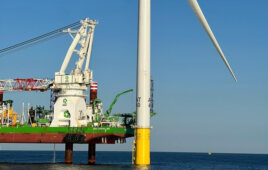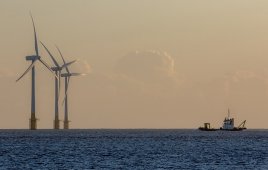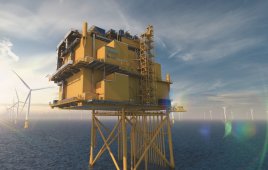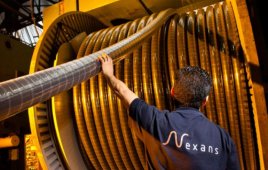Cables span the windpower industry from work in the nacelle, throughout the wind farm and substations, and then across the country in several grids, and all at various voltages.
The power cable in a nacelle may have a tougher job than the exposed wires on electric lines. In a nacelle, the power cable from a generator has to tolerate millions of twists, oil, and cold winter temperatures. An improving tolerance to each of these conditions describes cable trends.
Wind turbines transmit power from their generators to ground-based equipment through large cables capable of handling many Amps. But there are no slip rings to get this power out of a turning nacelle. To accommodate the necessity of yaw, the cable is run up the side of tower, over a 180° strain relief, into about 3-m long loop and then into the nacelle. This “slack” accommodates nacelle motion. But as you can imagine, in cold weather, cables stiffen, so the stranded copper conductors and insulation are a composition that should stay flexible. “Tests our company conducts in Europe involves five million twists at about 5 rpm,” says Lapp USA Senior Product Manager Rick Orsini.
Improved tolerance to cold weather is the cable trend. “At -40°C, cable insulation can become so brittle it will break off and expose conductors. One lab test calls for dropping a small weight on a cable frozen to -40°C. It shatters the insulation as if it were glass. That temperature is extreme but possible in turbines in cold weather regions,” says Orsini.
Another cabling trend is toward insulation that tolerates gear oil. Depending on the insulation material, with sufficient exposure to oil, insulation can swell and flake off, or become brittle and break off, again exposing conductors. Although gearboxes have improved in recent years, they still use oil that must be changed on occasion and that invites drips and spills that can find their way down that big cable loop below the nacelle. One company says oil spills in the nacelle are unavoidable.
No surprise that OEMs are looking for price concessions, perhaps the most universal trend. Turbine manufacturers setting up production in the U.S. often ask for halogen-free cable insulations. Halogen-free materials are often considered because, if exposed to flame, they would not outgas harmful compounds to nearby technicians. “However, considering that it is unlikely that anyone would be in a nacelle should a fire break out, the necessity of more expensive halogen free materials becomes less important,” says Orsini. PVC based insulation are less expensive and provide the oil and temperature performance needed. So far, adds Orsini, his company has been able to produce a halogen-free insulation good to -25°C.
Of course as turbines are getting larger the voltage outputs head up. (The generator on one recent 3-MW version produces 12,000V.) The UL WTTC (wind turbine tray cable) standard 1227 was frequently sited for 600V cables it describes. A more recent WTTC 2227 now describes 1,000V cables.
What about life-cycle costs? No surprise here: Not all cables are created equal. For most power transmission and distribution needs, high-voltage or medium-voltage cables are typically specified. They are often installed underground or underwater (submarine) and connect the wind farm to the grid. Power cable components usually consist of several different materials, including cross-linked polyethylene (XLPE), ethylene propylene rubber (EPR), and water-tree-retardant XLPE (TR-XLPE). However, not all cable materials deliver the same results. Hence, testing data and manufacturing standards are needed to predict performance. It is critical that wind developers are aware of how various materials perform in power-cable applications.
For instance, says one cable manufacturer, field studies over thirty years show that its cables exhibit little or no wear. This is due to jacketing and insulation materials resistant to moisture intrusion. Industry accepted tests estimate their lifespan at more than fourty years. This kind of performance is in line with wind-farm developers who are targeting a similar lifespan. Consider also lab and field testing of cable components performed by independent institutes such as Georgia Tech’s National Electric Energy Testing Research and Applications Center (NEETRAC). Specifically recommended is the Cable Design Aging Test, NEETRAC project 97-409.
Lastly, copper thieves have set their sights on grounding cables around wind turbines because most use copper conductors, and they are easy to pull up. One enterprising cable manufacturer fights the trend by costing two copper strands with a thin layer of tin on which they laser etch a serial number and web site that would let a metal recycler check to see if the copper is stolen or not. WPE
Filed Under: Cables & connectors




